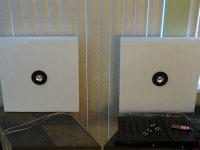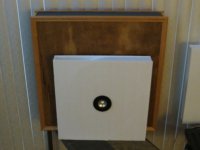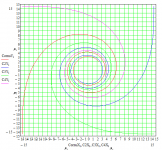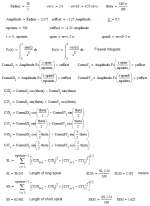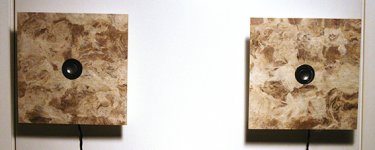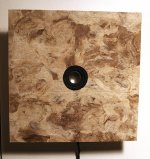Other way round. Mark used to work for Ted Jordan before starting Mark Audio. The drivers are old enough that I can't find much on them but this is about the 3rd generation of the 50mm cone drivers. There is only a surround, no spider so you have to be careful with excursion.
I would guess the Fs to be in the neighbourhood of 100Hz, maybe a bit less as they have a recommended XO of 120Hz when used with a woofer. Sensitivity is about 80 or 82 dB.
EDIT: I may not be right about the above as the driver cone is a little bigger than 50mm [hence the 6T designation?], more like 54mm and I have learned the 50mm cones had a very high Fs and a Qts well above 1.0 so I'm not sure what these are.
I would guess the Fs to be in the neighbourhood of 100Hz, maybe a bit less as they have a recommended XO of 120Hz when used with a woofer. Sensitivity is about 80 or 82 dB.
EDIT: I may not be right about the above as the driver cone is a little bigger than 50mm [hence the 6T designation?], more like 54mm and I have learned the 50mm cones had a very high Fs and a Qts well above 1.0 so I'm not sure what these are.
Is it my imagination but those Jordan's resemble Mark Audio's in frame, cone, and terminal locations.
The J6T was some of Mark's last work for Ted Jordan, In the kafuffle with EAD Mark ended up with the rights and the J6T was evolved into the Alpair 5.
dave
I am thinking.
I know that scares the people who know me so let me clear the air. This is about speakers.
I have to fulfill my duty as 'yes man' for my honey but when I am done, I'm going to hang a big ol' choke on the larger Cornus and a giant cap on the new ones and run them together as they seem to each have a niche to fill.
I know that scares the people who know me so let me clear the air. This is about speakers.
I have to fulfill my duty as 'yes man' for my honey but when I am done, I'm going to hang a big ol' choke on the larger Cornus and a giant cap on the new ones and run them together as they seem to each have a niche to fill.
The Cornu Spiral Function
I was wondering what a Cornu horn would look like if we were to actually use the true Cornu function which is also known as a clothoid. The cornu spiral is defined by the cosine and sine Fresnel integrals in the complex plane (x is real and y is imaginary). I worked this up in Mathcad with inputs for speaker exterior size (in inches) and the number of revolutions which then controls the length of the paths. The true Cornu spiral function has a much tighter spacing near the middle between channels and has an expansion that fully uses the entire edge of the speaker. So for a 28 in x 4 deep speaker, the horn mouth area would be 28 x 4 x 4 = 448 square inches or about double what the current design we are using. However it has much smaller throats (about 0.25 in wide) and a larger driver chamber. Note that the throat area is then about 2 square inches which would make the expansion ratio for the horn 224! Attached below are screen shots of the code in Mathcad and the resulting plot of the channels for a 28 in speaker with channel lengths of 2.2m and 1.63m - the two distances needed to help fill out bumps and dips in horn resonances. One can vary the spacing of the spiral to make it collapse to the middle quicker to widen the channels by adjusting the constant C. However, when C is not 0.5, the function is no longer a true Cornu spiral.
I was wondering what a Cornu horn would look like if we were to actually use the true Cornu function which is also known as a clothoid. The cornu spiral is defined by the cosine and sine Fresnel integrals in the complex plane (x is real and y is imaginary). I worked this up in Mathcad with inputs for speaker exterior size (in inches) and the number of revolutions which then controls the length of the paths. The true Cornu spiral function has a much tighter spacing near the middle between channels and has an expansion that fully uses the entire edge of the speaker. So for a 28 in x 4 deep speaker, the horn mouth area would be 28 x 4 x 4 = 448 square inches or about double what the current design we are using. However it has much smaller throats (about 0.25 in wide) and a larger driver chamber. Note that the throat area is then about 2 square inches which would make the expansion ratio for the horn 224! Attached below are screen shots of the code in Mathcad and the resulting plot of the channels for a 28 in speaker with channel lengths of 2.2m and 1.63m - the two distances needed to help fill out bumps and dips in horn resonances. One can vary the spacing of the spiral to make it collapse to the middle quicker to widen the channels by adjusting the constant C. However, when C is not 0.5, the function is no longer a true Cornu spiral.
Attachments
Well I have finished the babies. They are 7 1/2" square x 1 1/8" deep. Using a cheap little 1" 4om driver and I can't believe how good they sound. The shrillness is gone since sealing them up and the bass is quite good listening to some string quartets. Cello is full and smooth sounding and the soprano is great without any shrillness. I've matched them up with a little 8 watt TPA3110 amp from Sure running on a 12v battery. It's really quite amazing what a cheap little speaker can sound like.
Can't wait to finish the 18" ones.
Can't wait to finish the 18" ones.
Attachments
Prezden,
Awesome job, they look great! What did you decorate them with? I really like the look. I saw some similar 1 in aluminum concave cone pc speakers the other day for cheap. Now I want a set for my office. This is about the right size. 8 watt amp is pretty overkill for these babies, no?
Very nice job.
Awesome job, they look great! What did you decorate them with? I really like the look. I saw some similar 1 in aluminum concave cone pc speakers the other day for cheap. Now I want a set for my office. This is about the right size. 8 watt amp is pretty overkill for these babies, no?
Very nice job.

Well, after spending about a week reading this thread as well as the foam-core one, I'm about to take the plunge. First project will use the Tang Buyout w3-881si in a 20" mini using the original, more straightened arrangement. I've used the latest .pdf's "cornu clone spiral" and scaled them to the 20" size. Printed out as tiled pages, taped together, then transferred to the foam core board using graphite paper and subsequently going over with a Sharpie. Now I'm deciding how thick to make the box: the speakers are 2" deep, so would 2.5" be good? That would leave the throat very small (Sd=4.96 sq. in.), although it might be just about right because I don't know exactly the diameter of the speakers. A 1" throat with a 2.5" width would exactly meet what I think I've heard as the proper dimension (i.e., Throat = Sd/2, for each f the two channels).
I'm starting with foam core board, but am ultimately interested in something more sophisticated, maybe combining wood, metal, and clear plastic. But I want to understand better the acoustics. Any recommendations for a good book to start with?
Jon
I'm starting with foam core board, but am ultimately interested in something more sophisticated, maybe combining wood, metal, and clear plastic. But I want to understand better the acoustics. Any recommendations for a good book to start with?
Jon
Jsouder,
The 881si has a 32 sq cm Sd which is same as 5 sq in. I think throat is about 0.64 in wide for 20 incher. This says channels can be up to 3.8 in deep if you don't want any compression. Some compression may be good for driver with only 0.5 mm xmax to help load it and control cone excursion, so 2.5 in is probably fine. Good luck. A clear face that shows channels is very cool. If you do white foam core, it is translucent and a string of LED lights in channel will light it up well.
Have fun.
The 881si has a 32 sq cm Sd which is same as 5 sq in. I think throat is about 0.64 in wide for 20 incher. This says channels can be up to 3.8 in deep if you don't want any compression. Some compression may be good for driver with only 0.5 mm xmax to help load it and control cone excursion, so 2.5 in is probably fine. Good luck. A clear face that shows channels is very cool. If you do white foam core, it is translucent and a string of LED lights in channel will light it up well.
Have fun.
Has anyone tried the Vifa TC6FD? It appears to be the little brother to the 9FD. Looks like it might be an excellent choice for a circa 14 inch micro cornu.
http://www.parts-express.com/pe/showdetl.cfm?partnumber=264-1126
http://www.parts-express.com/pe/showdetl.cfm?partnumber=264-1126
Cal & XRK,
I'm getting ready to start a pair of Cornucopya's with the Altec Lansing 405A drivers I have. Near as I can tell, the 405A is close to the same size as the FF125wk, although when I measure the cone, it looks to me like 8.5 cm dia. pistonic size, or an S(d) = 57 cm**2, compared to the FF125wk spec of S(d)= 66.5 cm**2.
When I plotted the spiral (which Cal appears to have used at the start of this thread) for a 27" horn, I find a CC measuring 4.5" x 5" with throats about 17mm wide. If I use a channel depth of 5", this comes out to 43 cm**2 total for the two throats.
How do I get the total throat area up closer to S(d) which IIRC is what you recommend? Shrink the CC a bit?
Thanks, Jim
I'm getting ready to start a pair of Cornucopya's with the Altec Lansing 405A drivers I have. Near as I can tell, the 405A is close to the same size as the FF125wk, although when I measure the cone, it looks to me like 8.5 cm dia. pistonic size, or an S(d) = 57 cm**2, compared to the FF125wk spec of S(d)= 66.5 cm**2.
When I plotted the spiral (which Cal appears to have used at the start of this thread) for a 27" horn, I find a CC measuring 4.5" x 5" with throats about 17mm wide. If I use a channel depth of 5", this comes out to 43 cm**2 total for the two throats.
How do I get the total throat area up closer to S(d) which IIRC is what you recommend? Shrink the CC a bit?
Thanks, Jim
I decided to swap out the Jordan's for some LG - 6400WTTCO3A's. Ya, I know, a simple # to remember right? 
The Jordan's are going back on the shelf. I have loved this LG driver since I found them in a cute little box in a second hand shop somewhere a couple years ago. What a difference. This is now one 'o' them there goofy snail shaped styro boxes well suited to it's new tenant. These things sound great. Same funny feelings as the first one.
The Jordan's are going back on the shelf. I have loved this LG driver since I found them in a cute little box in a second hand shop somewhere a couple years ago. What a difference. This is now one 'o' them there goofy snail shaped styro boxes well suited to it's new tenant. These things sound great. Same funny feelings as the first one.
- Home
- Loudspeakers
- Full Range
- Ever think of building a Cornu Spiral horn? Now you can!
